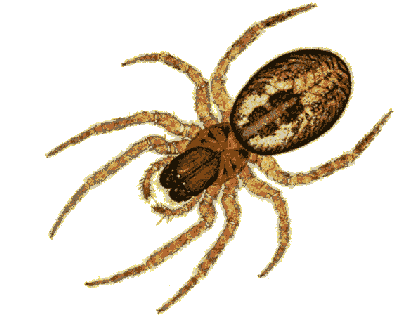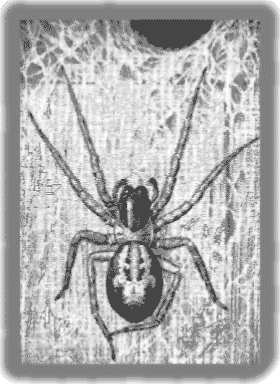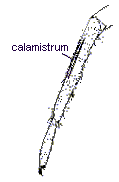

This month we have something totally different - a cribellate species,
Amaurobius
similis, which in terms of size is a relative monster -
well at least compared to last month's species.
Males are big enough at 6-8mm, but the females are even more impressive
ranging from 9 up to 12mm in length.
We've come indoors for this species.
Previous "spiders of the month" have been chosen because in my pitfall
traps I've caught lots of them at the time of the year.
In contrast, very few specimens of this species have appeared in my
pitfall samples. There have been a few in pit-traps in leaf litter on the
wooded island of Inchcailloch on Loch Lomond. More frequently, we have
caught these spiders in corrugated paper traps wrapped around tree trunks
- again in the woodland of Inchcailloch, but also on the trunks of conifers
on afforested peat bogs.
In actual fact, this is not quite accurate: just one or two specimens
belonged to A. similis and usually they were of the congener A.
fenestralis. This latter species is, in effect, the "outdoor" equivalent
of A. similis; both of these species inhabit cracks and crevices,
but the latter exploits those of human dwellings. For A. fenestralis,
this is reflected in the fact that we caught more inside the spaces of
corrugated papers traps (wrapped around the trunks of trees) than on the
exposed surfaces of sticky traps at the same locations.
There is also a third species, larger in size and more fearsome in
appearance as its name suggests - Amaurobius ferox - which tends
to live under stones.

Normally, A similis lives in holes and crevices such as one
might find in sheds and outside window frames of houses, where they spin
a rather diffuse web of lacy silk around the entrance to their retreat
- as shown here.
In autumn, though, they frequently come inside.
Indeed, just now a spider which might well be A. similis is
starring in a television advert for a battery powered mini-suction device
(essentially a pooter, which is a traditional arachnologists' collecting
device in the form of a tube held in the mouth so that specimens can be
sucked up - either into a specimen tube or trapped against a filter in
the tube). The purpose of the "electric pooter" is to enable the nervous
house-holder to remove the spider without having to touch it, but then
safely release the poor animal, unharmed, outside the house!
 |
As you know, spiders use their spinnerets to spin silk which they use
for all sorts of functions.
Amaurobius produces a special kind of silk from its cribellum, which is a pair of sieve-like plates just in front of the spinerets, as shown in the diagram on the left. The silk is very characteristic, with a blueish colour when fresh. The silk is produced from the cribellum in a large numbers of fine strands,
which are teased out by a double (in the case of Amaurobius) row
of curved bristles on the metatarsus of the fourth (hind) leg.
|
 |
| Return to..? | |
 Ariadne Home Page
Ariadne Home Page |
|